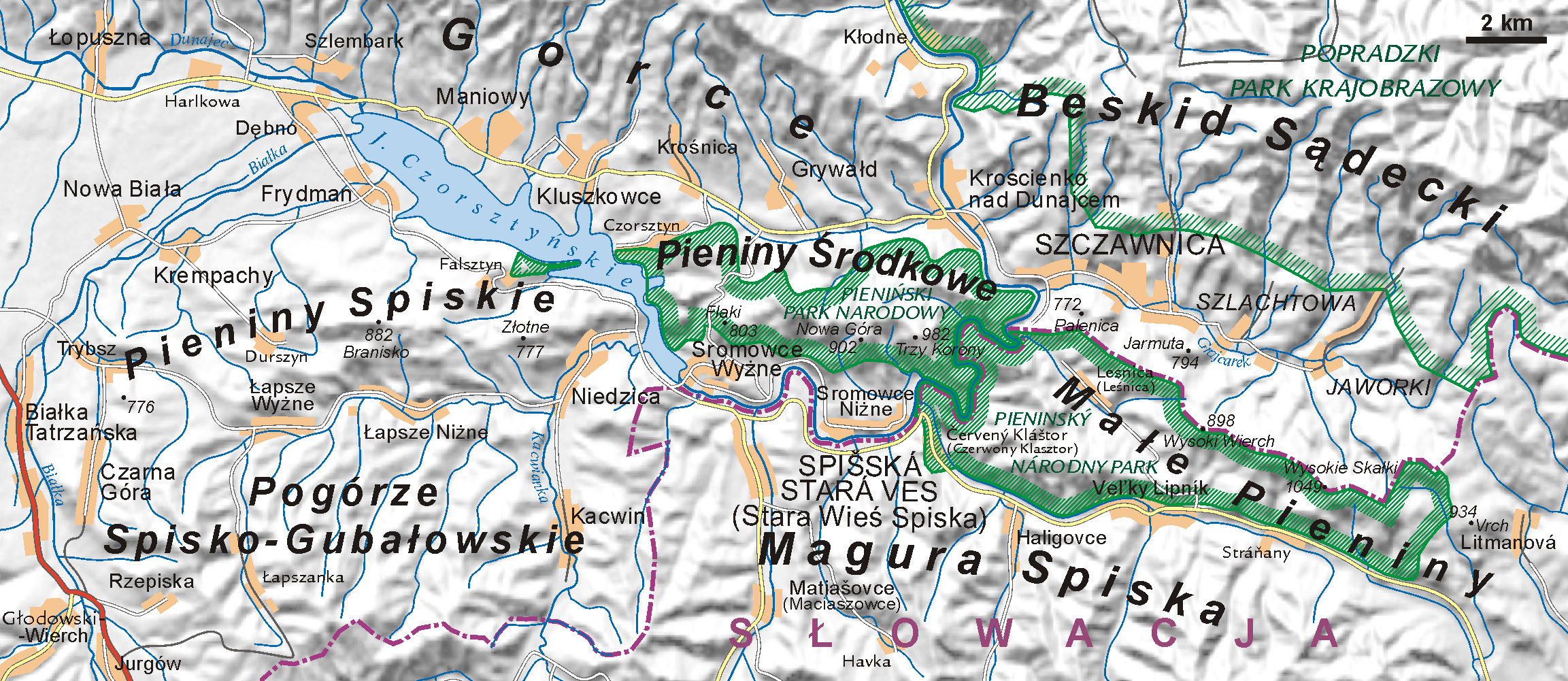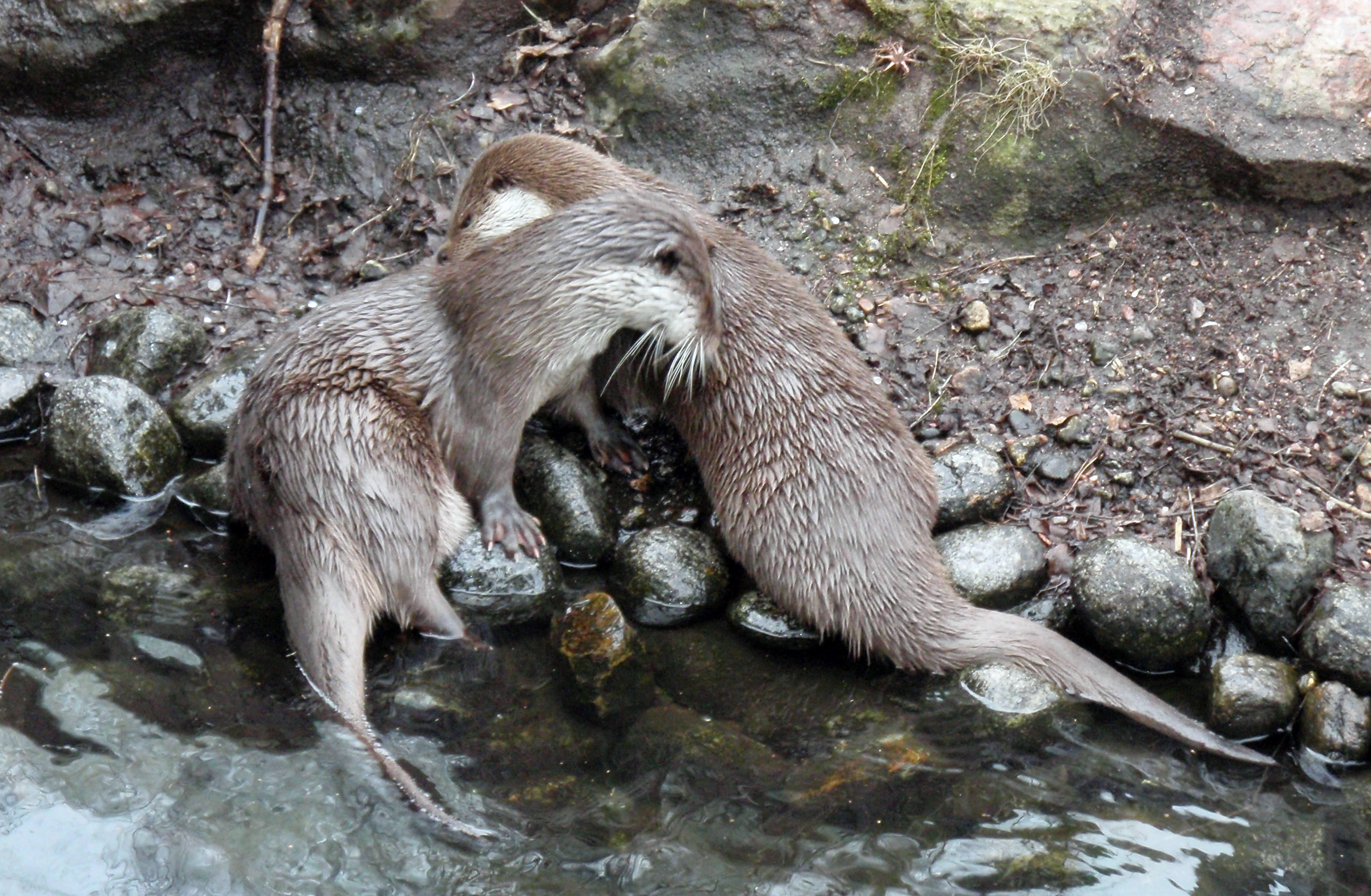|
Pieninský Národný Park
Pieniny National Park ( sk, Pieninský národný park; abbr. PIENAP) is a national park in northern Slovakia. The park is located in the eastern Pieniny, Pieniny Mountains on the border with Poland. It is the smallest national park in Slovakia with an area of 37.49 km2 (14.48 mi2) and a buffer zone of 224.44 km2 (86.66 mi2). The park is located in the Slovak districts of Kežmarok and Stará Ľubovňa in the Prešov Region. History The Zamagurie region was already declared as a protected territory in 1932, making it the first protected international nature park in Europe. On the Polish side it was called Pieniny National Park (Poland), Pieniński Park Narodowy, while the Slovak part of the Pieniny Mountains was a national nature reserve. The National Park itself was founded on 16 January 1967, which makes it the second oldest national park in Slovakia after the Tatra National Park, Slovakia, Tatra National Park. By the 1994 act of the Slovak parliament regarding ... [...More Info...] [...Related Items...] OR: [Wikipedia] [Google] [Baidu] |
Dunajec River
The Dunajec (); Goral dialects: ''Dónajec'') is a river running through northeastern Slovakia and southern Poland. It is also regarded as the main river of the Goral Lands. It is a right tributary of the Vistula River. It begins in Nowy Targ at the junction of two short mountain rivers, Czarny Dunajec and Biały Dunajec (Black and White Dunajec). Dunajec forms the border between Poland and Slovakia for in the Pieniny Środkowe (Slovak: Centrálne Pieniny) range, east of the Czorsztyn reservoir. Geography The Dunajec is long, including its source river Czarny Dunajec,Statistical Yearbook of the Republic of Poland 2017 [...More Info...] [...Related Items...] OR: [Wikipedia] [Google] [Baidu] |
Eurasian Otter
The Eurasian otter (''Lutra lutra''), also known as the European otter, Eurasian river otter, common otter, and Old World otter, is a semiaquatic mammal native to Eurasia. The most widely distributed member of the otter subfamily (Lutrinae) of the weasel family (Mustelidae), it is found in the waterways and coasts of Europe, many parts of Asia, and parts of northern Africa. The Eurasian otter has a diet mainly of fish, and is strongly territorial. It is endangered in some parts of its range, but is recovering in others. Description The Eurasian otter is a typical species of the otter subfamily. Brown above and cream below, these long, slender creatures are well-equipped for their aquatic habits. Their bones show osteosclerosis, increasing their density to reduce buoyancy. This otter differs from the North American river otter by its shorter neck, broader visage, the greater space between the ears and its longer tail. However, the Eurasian otter is the only otter in much of its ... [...More Info...] [...Related Items...] OR: [Wikipedia] [Google] [Baidu] |
Chamois
The chamois (''Rupicapra rupicapra'') or Alpine chamois is a species of goat-antelope native to mountains in Europe, from west to east, including the Alps, the Dinarides, the Tatra and the Carpathian Mountains, the Balkan Mountains, the Rila–Rhodope massif, Pindus, the northeastern mountains of Turkey, and the Caucasus. The chamois has also been introduced to the South Island of New Zealand. Some subspecies of chamois are strictly protected in the EU under the European Habitats Directive. Names The English name comes from French . The latter is derived from Gaulish ''camox'' (attested in Latin, 5th century), itself perhaps borrowing from some Alpine language (Raetic, Ligurian). The Gaulish form also underlies German , , , Italian , Ladin . The usual pronunciation for the animal is or , approximating the French pronunciation . However, when referring to chamois leather, and in New Zealand often for the animal itself, it is , and sometimes spelt ''shammy'' or ''chamy'' ... [...More Info...] [...Related Items...] OR: [Wikipedia] [Google] [Baidu] |
Eurasian Lynx
The Eurasian lynx (''Lynx lynx'') is a medium-sized wild cat widely distributed from Northern, Central and Eastern Europe to Central Asia and Siberia, the Tibetan Plateau and the Himalayas. It inhabits temperate and boreal forests up to an elevation of . Despite its wide distribution, it is threatened by habitat loss and fragmentation, poaching and depletion of prey. Taxonomy ''Felis lynx'' was the scientific name used in 1758 by Carl Linnaeus in his work '' Systema Naturae''. In the 19th and 20th centuries, the following Eurasian lynx subspecies were proposed: The following were also proposed, but are not considered valid taxa: *Altai lynx (''L. l. wardi'') *Baikal lynx (''L. l. kozlovi'') *Amur lynx (''L. l. stroganovi'') *Sardinian lynx (''L. l. sardiniae'') Characteristics The Eurasian lynx has a relatively short, reddish or brown coat that is marked with black spots; their number and pattern are highly variable. The underparts, neck and chin are whitish. The ... [...More Info...] [...Related Items...] OR: [Wikipedia] [Google] [Baidu] |
Wolf
The wolf (''Canis lupus''; : wolves), also known as the gray wolf or grey wolf, is a large canine native to Eurasia and North America. More than thirty subspecies of ''Canis lupus'' have been recognized, and gray wolves, as popularly understood, comprise wild subspecies. The wolf is the largest extant member of the family Canidae. It is also distinguished from other ''Canis'' species by its less pointed ears and muzzle, as well as a shorter torso and a longer tail. The wolf is nonetheless related closely enough to smaller ''Canis'' species, such as the coyote and the golden jackal, to produce fertile hybrids with them. The banded fur of a wolf is usually mottled white, brown, gray, and black, although subspecies in the arctic region may be nearly all white. Of all members of the genus ''Canis'', the wolf is most specialized for cooperative game hunting as demonstrated by its physical adaptations to tackling large prey, its more social nature, and its highly advanc ... [...More Info...] [...Related Items...] OR: [Wikipedia] [Google] [Baidu] |
Eurasian Brown Bear
The Eurasian brown bear (''Ursus arctos arctos'') is one of the most common subspecies of the brown bear, and is found in much of Eurasia. It is also called the European brown bear, common brown bear, common bear, and colloquially by many other names. The genetic diversity of present-day brown bears (''Ursus arctos'') has been extensively studied over the years and appears to be geographically structured into five main clades based upon analysis of the mtDNA. Description The Eurasian brown bear has brown fur, which ranges from yellowish-brown to dark brown, red-brown, and almost black in some cases; albinism has also been recorded. The fur is dense to varying degrees and the hair can grow up to in length. The head normally is quite round in shape and has relatively small rounded ears, a wide skull and a mouth equipped with 42 teeth, including predatory teeth. It has a powerful bone structure and large paws equipped with claws that can grow up to in length. The weight varie ... [...More Info...] [...Related Items...] OR: [Wikipedia] [Google] [Baidu] |
Libanotis Montana Sibirica
''Seseli'' is a genus of herbaceous perennial plants in the family Apiaceae. They are sometimes woody at base with a conic taproot. Leaf blades are 1–3-pinnate or pinnately decompound. Umbels are compound, with bracts few or absent. Petals are white or yellow, and the fruit ovoid or ellipsoid. There are about 140 species in the genus.Güner, E. D., et al. (2011)Pollen morphology of the genus ''Seseli'' L.(Umbelliferae) in Turkey.''Turkish Journal Botany'' 35 175-82. Species , Plants of the World Online accepted the following species: *'' Seseli abolinii'' (Korovin) Schischk. *'' Seseli acaulis'' (R.H.Shan & M.L.Sheh) V.M.Vinogr. *'' Seseli aemulans'' Popov *'' Seseli afghanicum'' (Podlech) Pimenov *'' Seseli alaicum'' Pimenov *'' Seseli albescens'' (Franch.) Pimenov & Kljuykov *'' Seseli alboalatum'' (Haines) Pimenov & Kljuykov *'' Seseli alexeenkoi'' Lipsky *'' Seseli andronakii'' Woronow ex Schischk. *''Seseli annuum'' L. *'' Seseli arenarium'' M.Bieb. *'' Seseli aroanicu ... [...More Info...] [...Related Items...] OR: [Wikipedia] [Google] [Baidu] |
Taraxacum Pieninicum
''Taraxacum'' () is a large genus of flowering plants in the family Asteraceae, which consists of species commonly known as dandelions. The scientific and hobby study of the genus is known as taraxacology. The genus is native to Eurasia and North America, but the two most commonplace species worldwide, '' T. officinale'' (the common dandelion) and '' T. erythrospermum'' (the red-seeded dandelion), were introduced from Europe into North America, where they now propagate as wildflowers. Both species are edible in their entirety. The common name ''dandelion'' ( , from French , meaning 'lion's tooth') is also given to specific members of the genus. Like other members of the family Asteraceae, they have very small flowers collected together into a composite flower head. Each single flower in a head is called a ''floret''. In part due to their abundance, along with being a generalist species, dandelions are one of the most vital early spring nectar sources for a wide host ... [...More Info...] [...Related Items...] OR: [Wikipedia] [Google] [Baidu] |
Chrysanthemum Zawadzkii
''Chrysanthemum zawadzkii'' is a species of short perennial herb in the family Asteraceae native to Europe. The species was described from the Pieniny mountains in 1829 by Franz Herbich and named after Aleksander Zawadzki Aleksander Zawadzki, alias Kazik, Wacek, Bronek, One (; 16 December 1899 – 7 August 1964) was a Polish communist politician, first Chairman of the Council of State of the People's Republic of Poland, divisional general of the Polish Army .... The species is also known to occur in Russia extending to Japan. References zawadzkii Flora of Malta {{Asteroideae-stub ... [...More Info...] [...Related Items...] OR: [Wikipedia] [Google] [Baidu] |
Endemism
Endemism is the state of a species being found in a single defined geographic location, such as an island, state, nation, country or other defined zone; organisms that are indigenous to a place are not endemic to it if they are also found elsewhere. For example, the Cape sugarbird is found exclusively in southwestern South Africa and is therefore said to be ''endemic'' to that particular part of the world. An endemic species can be also be referred to as an ''endemism'' or in scientific literature as an ''endemite''. For example '' Cytisus aeolicus'' is an endemite of the Italian flora. '' Adzharia renschi'' was once believed to be an endemite of the Caucasus, but it was later discovered to be a non-indigenous species from South America belonging to a different genus. The extreme opposite of an endemic species is one with a cosmopolitan distribution, having a global or widespread range. A rare alternative term for a species that is endemic is "precinctive", which applies to ... [...More Info...] [...Related Items...] OR: [Wikipedia] [Google] [Baidu] |
Limestone
Limestone ( calcium carbonate ) is a type of carbonate sedimentary rock which is the main source of the material lime. It is composed mostly of the minerals calcite and aragonite, which are different crystal forms of . Limestone forms when these minerals precipitate out of water containing dissolved calcium. This can take place through both biological and nonbiological processes, though biological processes, such as the accumulation of corals and shells in the sea, have likely been more important for the last 540 million years. Limestone often contains fossils which provide scientists with information on ancient environments and on the evolution of life. About 20% to 25% of sedimentary rock is carbonate rock, and most of this is limestone. The remaining carbonate rock is mostly dolomite, a closely related rock, which contains a high percentage of the mineral dolomite, . ''Magnesian limestone'' is an obsolete and poorly-defined term used variously for dolomite, for limes ... [...More Info...] [...Related Items...] OR: [Wikipedia] [Google] [Baidu] |


_Chamois.png)

.png)
_female_3.jpg)

.jpg)
